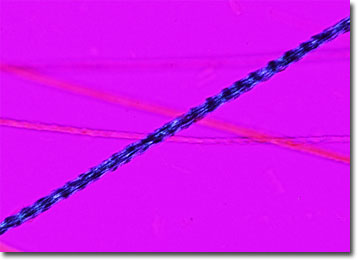Polarized Light Microscopy Digital Image Gallery
Bat Hair
In the western world, bats have historically been thought of in negative terms, largely because of their association with the legendary blood-sucking vampires. In some other parts of the world, however, these winged mammals are considered signs of good luck and longevity.

Bats, which are members of the order Chiroptera, are the only mammals that are truly capable of flight. The wings of the intriguing animals vary greatly in size, wingspreads ranging from only a few inches to as many five feet. Those at the higher end of the size spectrum, such as the flying foxes of the Malay region, are frequently hunted as a source of food. Bats also differ in a number of other regards, such as fur type and habitat, there being approximately 900 species of them identified and classified into 200 genera. Most, however, are nocturnal, communal, and rest hanging head down.
Found in most parts of the world, but most prevalent in the tropics, bats are generally quite beneficial to humans. The insect-eating varieties, for instance, help control pest populations, while the fruit and pollen eating bats facilitate seed dispersal and pollination. The guano generated by bats is also useful as a fertilizer. Nevertheless, bats are themselves sometimes considered pests due to the damage they can cause to commercial crops and their occasional invasion of barns, buildings, and other human habitations. Moreover, the vampire bats of tropical America can transmit rabies and other viruses, causing harm to livestock, even though the relatively small amounts of blood they consume is often negligible.
